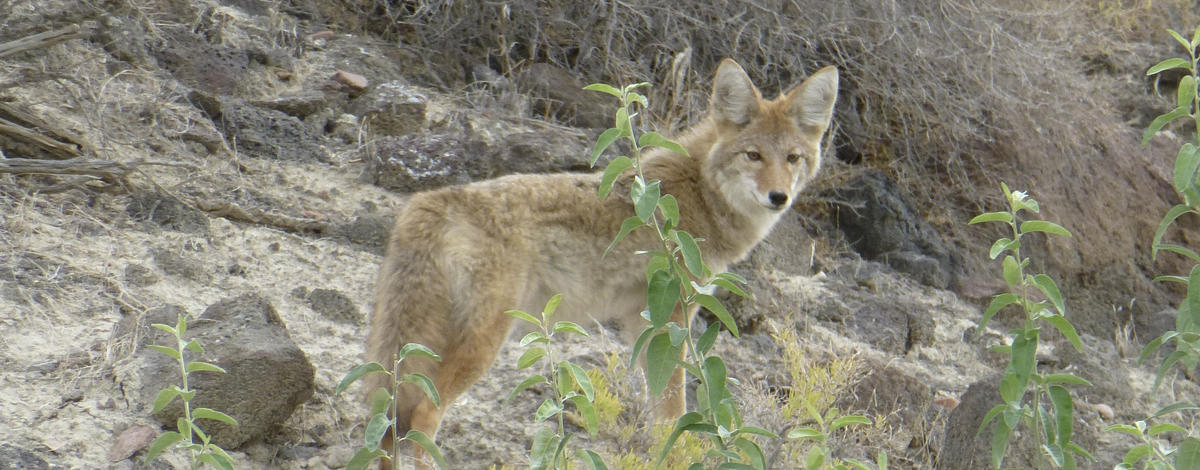Idaho Fish and Game recently received a report of coyotes attacking a dog in the Boise Foothills. Wildlife managers and enforcement staff are monitoring the situation closely. To keep people and their pets safe, Fish and Game is recommending that recreationists with dogs avoid the area for the next few weeks.

Coyote conflicts with off-leash dogs continue in the Boise foothills
F&G recommends recreationists with dogs avoid Lower Hulls Gulch trail for a few weeks
Fish and Game staff at the Nampa Regional Office received the report on Friday, March 31 that an individual was hiking with an off-leash dog on the Lower Hulls Gulch trail, above the Red Cliff trail, when their 72-pound dog was reportedly attacked by three coyotes, causing flanking injuries that required veterinary care.
The recent attack in the Boise foothills occurred during the coyote denning season, when coyotes become more territorial toward other canines, including domestic dogs. While they can occur at any time of year, coyote conflicts with domestic dogs typically peak between late February and June, which spans the breeding and denning seasons. Conflicts have occurred in each of the past three years in this specific area, which is popular with hikers but also provides excellent denning habitat for coyotes.
“This area is preferred denning habitat as we have reports of coyotes denning in this area every year in the past three years,” Walrath said.
Fish and Game’s Magic Valley Region office has also recently received reports of dog-aggressive coyotes in Twin Falls and Hagerman, and the Southwest Region has had multiple reports of dog-aggressive coyotes in Southeast Boise, including one attack in mid-March.
“Unfortunately, it is not a rare occurrence that coyotes get territorial with dogs this time of year—and the incidents are not limited to just this area,” Regional Wildlife Manager Ryan Walrath said. “It can happen anywhere in the foothills, and anywhere where coyotes are denning, even a city park.”
In addition to Fish and Game biologists encouraging recreationists to avoid areas where dog-aggressive coyotes have been documented altogether for a period of a few weeks, biologists also strongly recommend keeping dogs on leash on all Boise Foothill trails – even trails where dogs are permitted to be off-leash –between the months of March and June.
“Taking these steps can help minimize the risk, because being in close proximity to a leashed dog is a much greater deterrent to a coyote. But being on leash doesn’t absolutely guarantee a territorial coyote won’t cause problems with a dog,” Walrath said. “When an area is known to have dog-aggressive coyotes, the safest short-term option is for recreationists to find another area to hike with their dogs.”
While coyote attacks on domestic dogs in the Boise area are not an everyday occurrence, coyotes have attacked and killed domestic dogs before — even within the city limits. It is not uncommon for coyotes to be territorial with domestic dogs, particularly around den sites when raising pups in the spring and early summer.
Here are some steps recreationists and homeowners can take to keep their pets safe and prevent coyotes from becoming habituated to humans:
Recreationists
- Keep dogs on leash when using trails.
- If you know that an area has recently experienced coyote conflicts, consider using a different area that is open to recreation.
- Consider bringing a loud noisemaker with you – a whistle, bell or horn – which can be helpful in scaring off a coyote.
- Another option is carrying bear spray and knowing how to use it. It’s not just for bears and can also be used as a highly effective tool against other mammals if an unsafe wildlife encounter occurs.
- When hiking, make noise to announce your presence. Coyotes are more leery around humans.
- Be present in the moment, and aware of your surroundings and your dog.
Homeowners
- Remove or secure coyote attractants — such as pet food, trash or dog feces — as well as attractants for native species that coyotes are known to prey on. Coyotes eat small animals such as rodents, squirrels, gophers, opossums, raccoons, skunks and foxes.
- Enclose backyard poultry, livestock, or other small animals that live outside with secure fencing and a roof.
- Don’t leave your dog outside unsupervised, particularly in areas where coyote conflicts have been known to occur.
- If possible, ensure your property boundaries are secure by keeping fences in good repair and letting your dogs out for bathroom breaks only in fenced areas, particularly at night. The American Kennel Club recommends solid fences of at least 6-feet tall, and buried in the ground at least 18 inches, and says that “coyote rollers” can provide additional deterrence.
- If your property is not fenced, turn on outside lights and make noise before letting your dog outside, and consider taking your dog out on a leash for nighttime bathroom breaks.
- Clear away brushy areas around your property that coyotes may see as safe denning or hiding spots.
